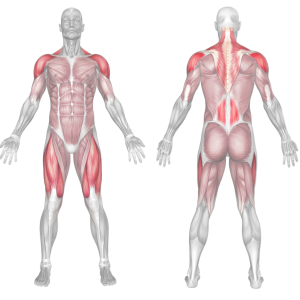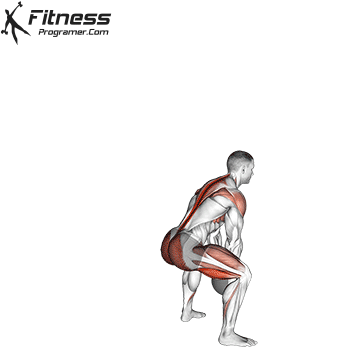Backward Medicine Ball Throw
The backward medicine ball throw is a plyometric exercise that involves explosively throwing a medicine ball backward over your head. This exercise primarily targets the muscles of the upper body, including the back, shoulders, and arms, while also engaging the core muscles for stability and coordination. Here’s how you can perform the exercise commonly used in strength and conditioning training:
How to do:
- Begin by standing with your feet shoulder-width apart, knees slightly bent, and core engaged.
- Maintain a firm grip on the ball and ensure that your wrists are straight.
- Extend your arms upward, fully raising the medicine ball above your head.
- From this overhead position, forcefully and explosively throw the medicine ball backward.
- As you throw the ball backward, allow your arms to follow through with the movement, extending them fully.
- Maintain a straight posture and engage your core muscles to provide stability during the throw.
- Retrieve the medicine ball and repeat the exercise for the desired number of repetitions.
Tips:
- Start with a lighter medicine ball and gradually increase the weight as you become more comfortable and stronger.
- To ensure proper engagement of the lower back muscles during the backward medicine ball throw, focus on maintaining good posture, engaging your core, and avoiding excessive arching or rounding of the spine. Keep your gaze forward and maintain a neutral neck position throughout the exercise.
- Ensure that you have enough space and a safe environment to perform the exercise.
- It’s advisable to work with a qualified trainer or coach if you’re new to this exercise, as they can guide you in maintaining proper form and technique.
- As always, consult with a healthcare professional or fitness expert before starting any new exercise program, particularly if you have any underlying medical conditions or injuries.
Backward Medicine Ball Throw – Benefits
Upper Body Strength: The backward medicine ball throw primarily targets the muscles of the upper body, including the shoulders, back, and arms. By consistently performing this exercise, you can develop and strengthen these muscle groups, leading to improved upper body strength.
Power and Explosiveness: The explosive nature of the backward medicine ball throw requires you to generate power quickly and forcefully. This exercise engages your fast-twitch muscle fibers, which are responsible for producing powerful and explosive movements. Over time, this can enhance your overall power and explosiveness in various athletic activities.
Core Stability: To execute the backward throw effectively, you need to engage your core muscles for stability and control. Your abdominal muscles, obliques, and lower back muscles work together to maintain proper posture and transfer power from the lower body to the upper body. This exercise helps strengthen your core and improve stability, which is essential for functional movements and sports performance.
Sports-Specific Application: The backward medicine ball throw mimics the throwing motion required in many sports, such as baseball, softball, football, and basketball. By incorporating this exercise into your training routine, you can enhance your ability to generate power and explosiveness in sport-specific movements, resulting in improved athletic performance.
Full-Body Coordination: Performing the backward medicine ball throw involves coordinating the movement of your lower body, core, and upper body. It requires proper sequencing and timing to generate maximum power and release the ball at the right moment. Regular practice of this exercise can improve your overall coordination and kinesthetic awareness.
Calorie Burn and Metabolic Boost: The backward medicine ball throw is a high-intensity exercise that engages multiple muscle groups. When performed as part of a well-rounded workout routine, it can help increase calorie expenditure, contributing to weight management goals. Additionally, high-intensity exercises like this can stimulate your metabolism, leading to a post-workout calorie burn effect.
Backward Medicine Ball Throw – Muscle Activation
While the backward medicine ball throw primarily targets the upper body muscles, it also involves the lower body, particularly the hips and legs, to generate power and provide a strong base for the throw.

- Deltoids: The deltoid muscles, specifically the anterior (front), middle, and posterior (rear) heads, are highly activated during the backward medicine ball throw. These muscles contribute to shoulder abduction and extension, generating force to propel the ball backward.
- Latissimus Dorsi: The large muscles of the back, known as the latissimus dorsi or “lats,” play a significant role in the backward throw. They assist in shoulder extension, adduction, and internal rotation, providing power and stability during the throwing motion.
- Trapezius: The trapezius muscles, particularly the middle and lower fibers, are activated to stabilize and control scapular movement. They help maintain proper shoulder positioning throughout the backward throw.
- Rotator Cuff Muscles: The rotator cuff muscles, including the supraspinatus, infraspinatus, teres minor, and subscapularis, work synergistically to stabilize the shoulder joint during the backward throw. They provide stability and control, preventing excessive stress and potential injuries.
- Core Muscles: The backward medicine ball throw engages various core muscles to maintain stability and transfer power from the lower body to the upper body. The rectus abdominis, obliques, and erector spinae muscles work together to provide a solid foundation for the throwing motion.
- Erector Spinae: The erector spinae muscles are a group of muscles that run along the length of the spine and are responsible for extending and stabilizing the back. During the backward medicine ball throw, these muscles work isometrically to maintain proper posture and provide stability throughout the movement.
- Chest Muscles: While the chest muscles are not the main drivers of the backward medicine ball throw, they do provide stability and support to the shoulder joint and upper body during the exercise. They assist in maintaining proper alignment and control, especially during the initial phases of the movement.
Biomechanics:
- Hip and Knee Extension: The backward throw initiates with a powerful extension of the hips and knees, generating force from the lower body. This action creates a strong foundation for the subsequent upper body movement.
- Triple Extension: The backward medicine ball throw involves a triple extension, which refers to the simultaneous extension of the ankles, knees, and hips. This coordinated extension optimizes power production and contributes to the explosive nature of the exercise.
- Shoulder Abduction and Extension: As the medicine ball is propelled backward, the shoulder joint undergoes abduction (moving the arm away from the body) and extension (moving the arm backward). This movement pattern maximizes the range of motion and power output of the shoulder muscles.
- Transverse Plane Rotation: The backward throw incorporates transverse plane rotation, where the trunk rotates to generate additional power and facilitate the throwing motion. This rotation is driven by the activation of the core muscles, especially the obliques.

